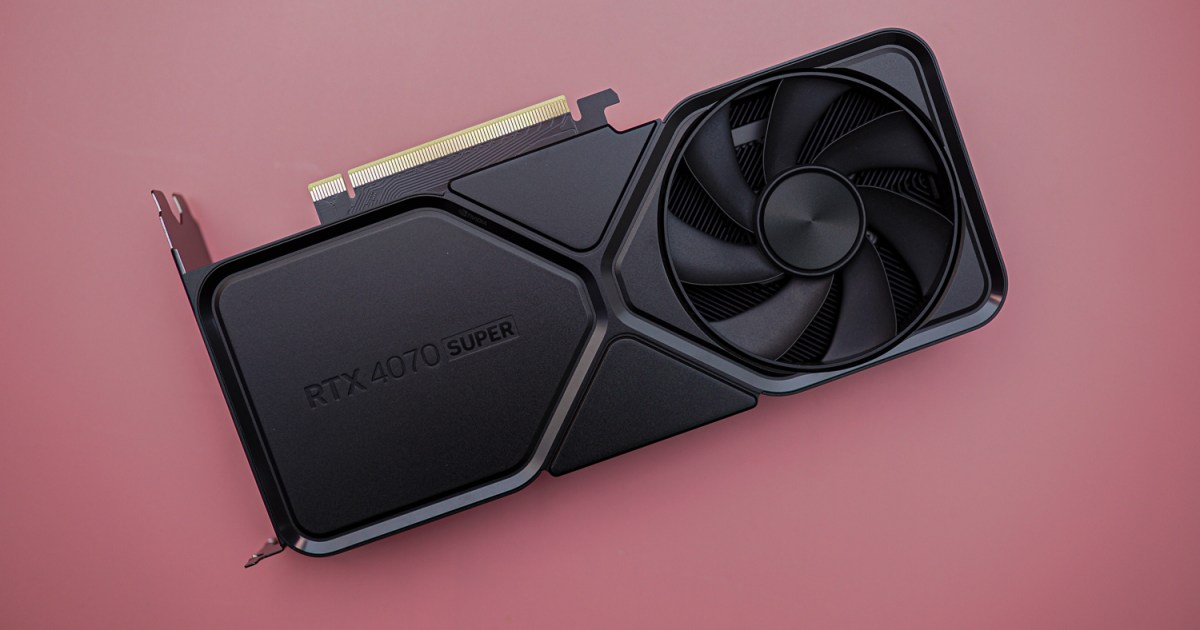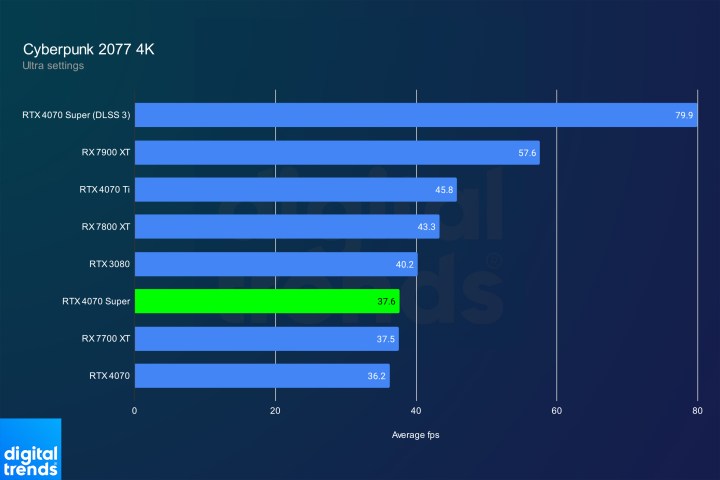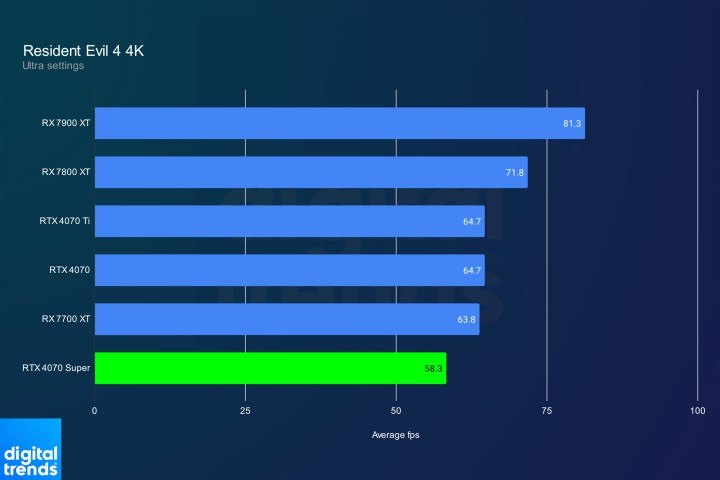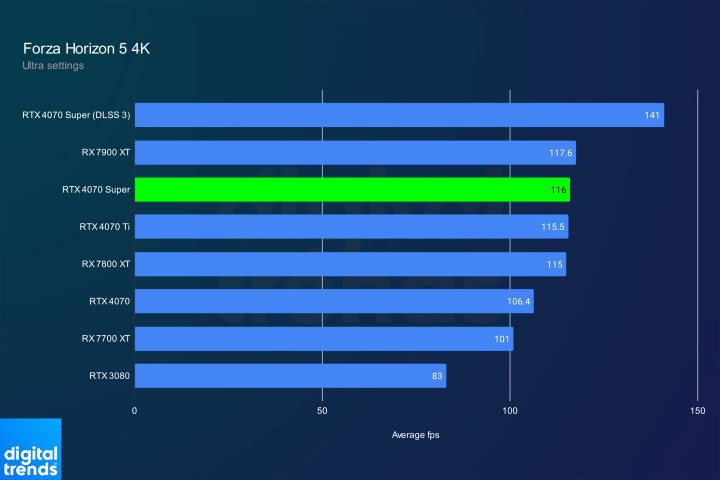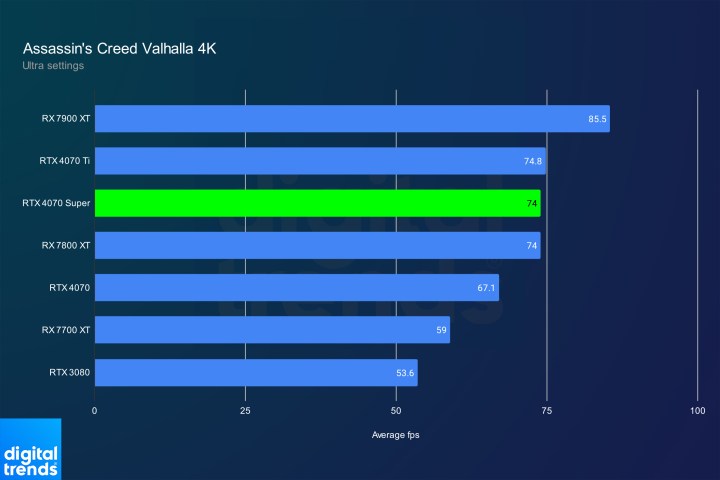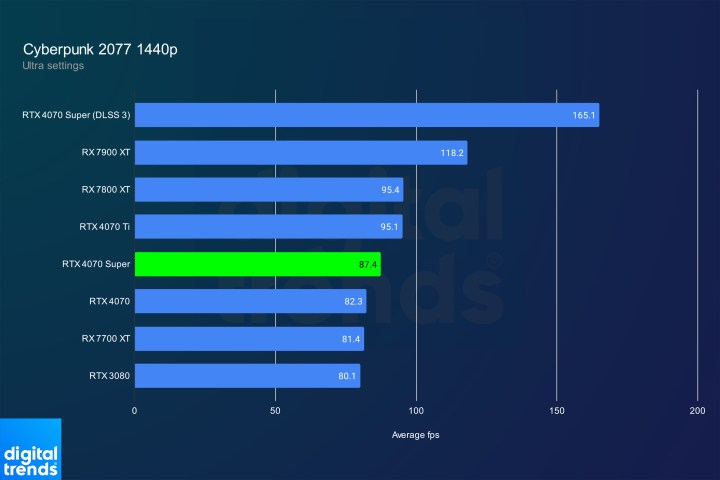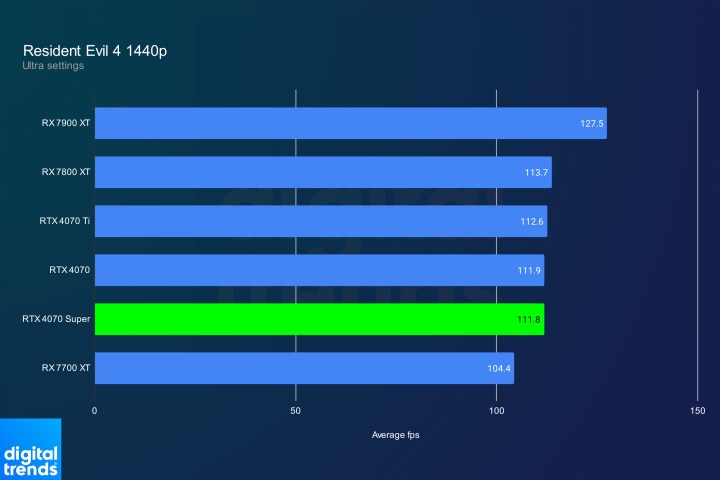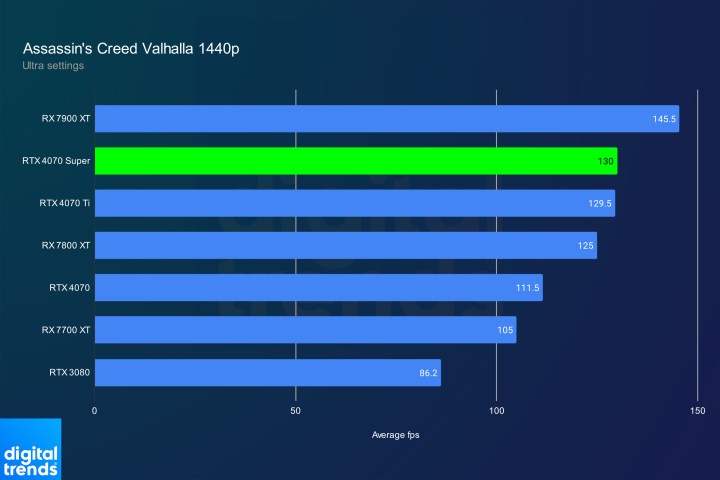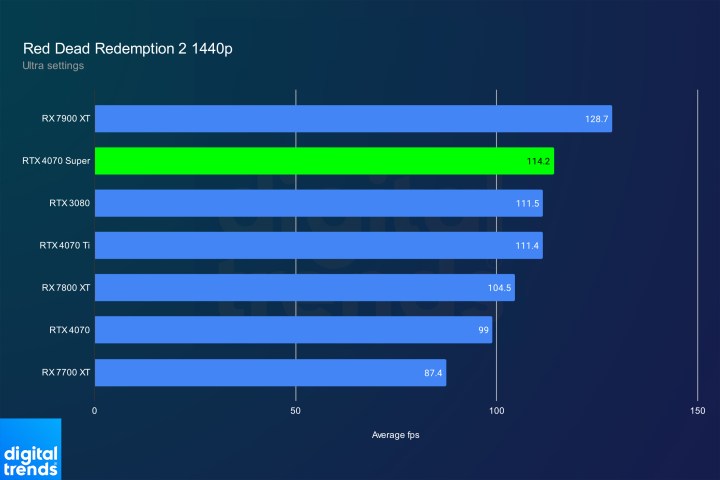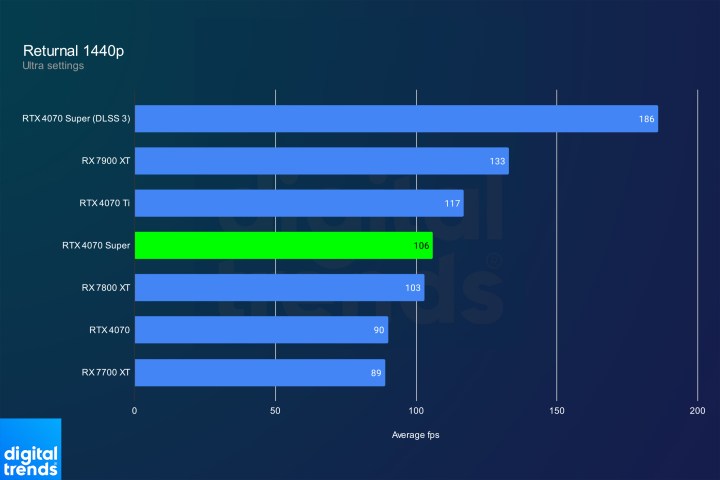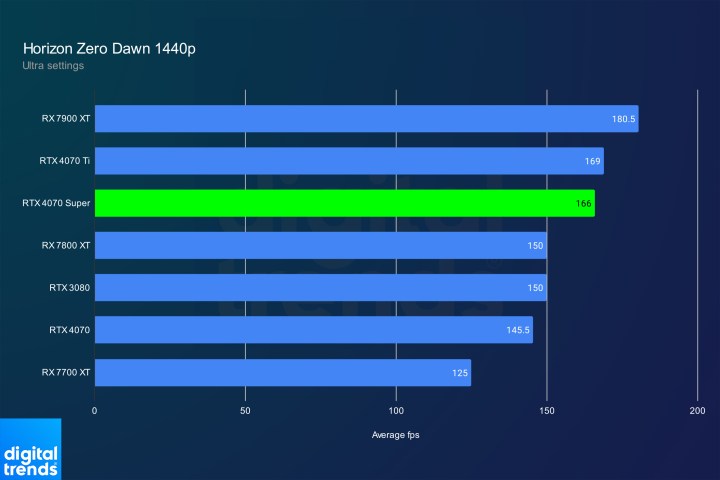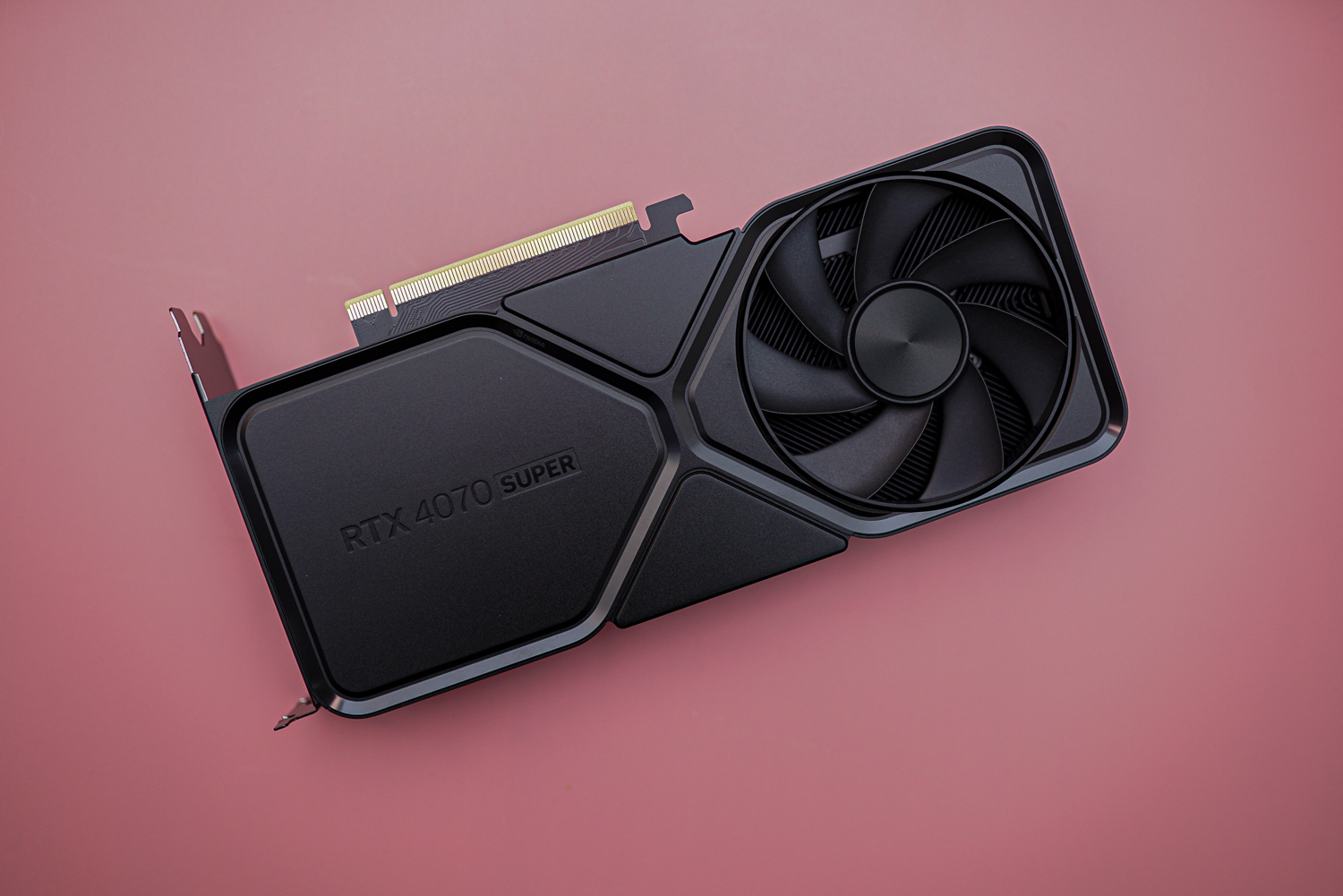
Nvidia RTX 4070 Super
MSRP $600.00
“The RTX 4070 Super is the graphics card you’ve been waiting for.”
Pros
- Solid performance improvement over RTX 4070
- Still highly efficient
- DLSS 3.5
- Fantastic ray tracing performance
- Great value
Cons
- Only minor uplifts in a few games
- 12GB of VRAM may limit some ray-traced titles at 4K
Nvidia needed a response. The RTX 4070 has held strong as one of the best graphics cards you can buy, but after losing some positions to AMD’s cheaper RX 7800 XT, Nvidia needed to come back with a vengeance. The result is the RTX 4070 Super, a GPU that not only reaffirms Nvidia’s position at the top of this price bracket but also calls into question the other GPUs Nvidia has released this generation.
The RTX 4070 Super is part of a trio of GPUs that Nvidia is giving the Super treatment to, and I suspect it will remain the most impressive. It packs the largest spec bump out of the entire range, and based on the performance I’m seeing, that makes a world of difference for this $600 GPU.
Specs

The RTX 4070 Super has a massive spec upgrade. It’s still on the AD104 GPU like the base RTX 4070, but Nvidia bumped the core count massively. You’re getting a 20% increase in CUDA cores, totaling 7,168 cores. That’s nearly as many as the $800 RTX 4070 Ti has.
The core count is the main draw here, but Nvidia also bumped up power just a bit. The RTX 4070 Super has a Total Graphics Power (TGP) of 220 watts, while the base model came in at 200W. It’s not a massive change realistically, especially given the remarkable efficiency we’ve seen from Nvidia this generation. A little extra juice doesn’t hurt here, giving the cores more power to play with.
| RTX 4070 Super | RTX 4070 | |
| GPU | AD104 | AD104 |
| Interface | PCIe 4.0 | PCIe 4.0 |
| CUDA cores | 7,168 | 5,888 |
| Boost clock | 2,475MHz | 2,475MHz |
| Memory | 12GB GDDR6X | 12GB GDDR6X |
| Memory speed | 21 Gbps | 21 Gbps |
| Memory bus | 192-bit | 192-bit |
| TDP | 220W | 200W |
That’s what’s different, but Nvidia kept some of the specs the same. Namely, the memory interface on the RTX 4070 Super is identical to the base model. You’re getting 12GB of GDDR6X memory on a 192-bit bus, along with 48MB of L2 cache to improve the bandwidth over that more narrow bus. Even among VRAM concerns in games, 12GB shouldn’t be too limiting. There are rare cases where it can become an issue at 4K with ray tracing, but those aren’t realistic gameplay settings for the RTX 4070 Super.
In addition, the clock speed remains mostly the same, with a boost block of 2.48GHz. The base clock speed has a slight bump, but as we’ve seen from GPUs over the past several generations, most models are already pushed to the brink of clock speed out of the box.
How does a 20% boost in core count translate into real performance? It’s not quite linear scaling, but the RTX 4070 Super still manages to impress.
Synthetic performance
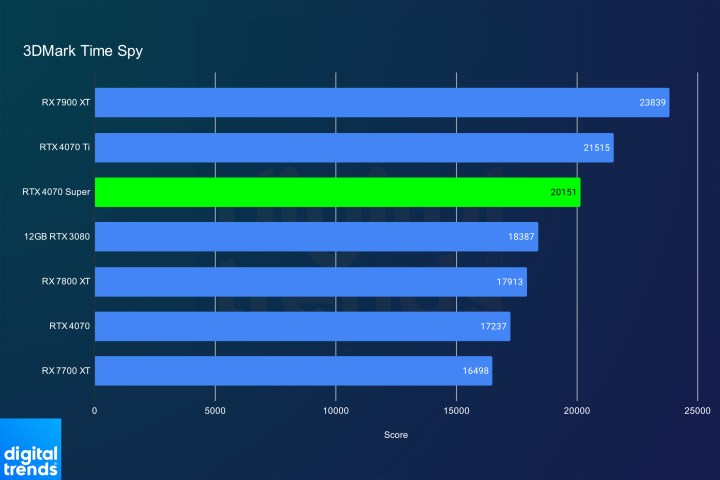
3DMark is actually a very important benchmark for the RTX 4070 Super. Remember, this card is still based on Nvidia’s Ada Lovelace architecture, so some games will appreciate the bump in cores more than others. 3DMark provides a nice foundation to understand where the card lands overall.
Compared to the RTX 4070 in 3DMark Time Spy, the Super model comes in 17% faster. That’s a massive improvement, putting Nvidia ahead of not only the 12GB RTX 3080 but also AMD’s RX 7800 XT. Perhaps more impressive is how close the Super model gets to the RTX 4070 Ti. The base RTX 4070 Ti is only 7% faster despite being 33% more expensive.
Time Spy is an aging benchmark, however, and a better representation of a modern gameplay experience is found in Port Royal. This benchmark leverages DirectX 12 and ray tracing, and the RTX 4070 Super looks even better compared to the competition from AMD.
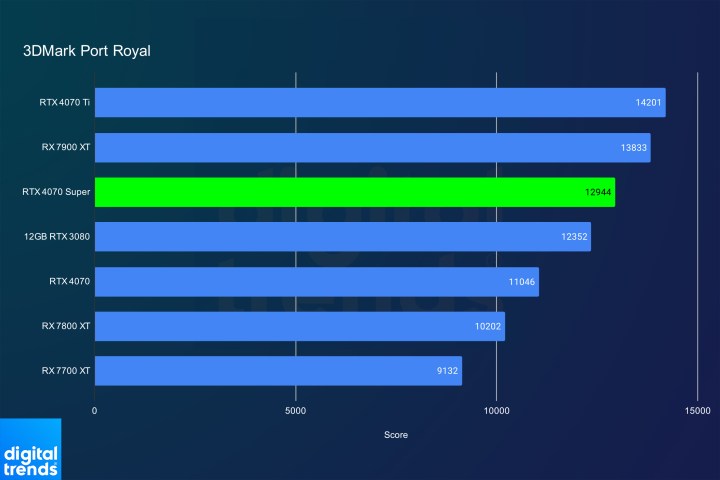
We’re once again seeing around a 17% improvement over the base RTX 4070, but the Super model manages a massive 27% lead over the RX 7800 XT. It closes in on the RX 7900 XT, in fact, showing that Nvidia still claims the crown in ray tracing.
A performance improvement of 17% is great for a card coming in at the same price, but we need to look into how that holds up in real games.
4K gaming
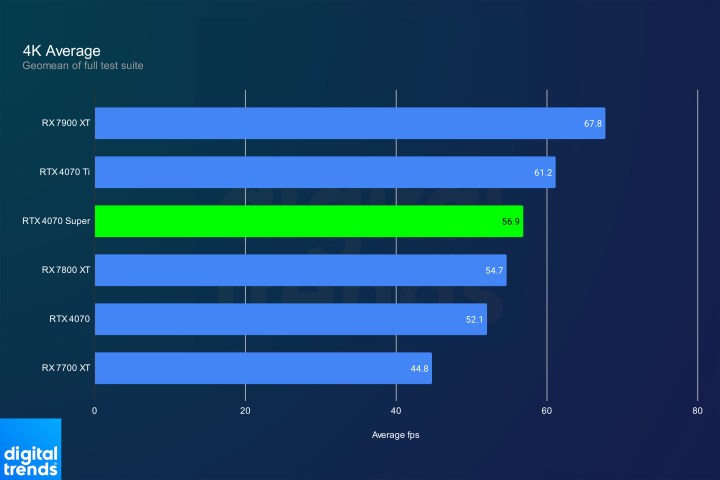
Nvidia doesn’t market the RTX 4070 Super as a 4K graphics card, but it can certainly hang at that resolution, assuming you’re willing to settle for a 60 frames per second (fps) target in most games. Across my full test suite, including games with ray tracing, the RTX 4070 Super averages 56.9 fps. That’s without Nvidia’s DLSS 3.5 brought into the mix, so there’s certainly enough power here for 4K with some small compromises.
However, the lead the RTX 4070 Super held in 3DMark isn’t as impressive in actual games. It ended up about 9% faster than the base RTX 4070. It’s also about 7% slower than the RTX 4070 Ti, which falls in line with Nvidia’s original claims about the card. The most significant comparison is to the RX 7800 XT, however, where Nvidia now holds a minor 4% lead.
Why the slip in performance compared to 3DMark? It looks like some games don’t care as much for the boosted specs on the RTX 4070 Super. Remember, this Super model has nearly as many cores as the RTX 4070 Ti, but it still takes a clear back seat in power and clock speed.
Titles like Cyberpunk 2077 and Resident Evil 4 have some problems, with the RTX 4070 Super barely providing any uplift over the base model. In the case of Resident Evil 4, it was actually a bit slower. I suspect this has to do with drivers for my review unit, but it was repeatable across resolutions (more on that in the ray tracing section below).
There are a couple of misses, but the RTX 4070 Super wins far more often than it loses. In Returnal, we see nearly a 20% jump over the RTX 4070, finally crossing the 60 fps line. And in Red Dead Redemption 2, the RTX 4070 Super is nearly identical to the RTX 4070 Ti, providing a solid 14% jump over the base model. The situation isn’t too different in Horizon Zero Dawn, where the RTX 4070 Super ends up just two frames short of the RTX 4070 Ti.
The same is true in Assassin’s Creed Valhalla and Forza Horizon 5. In the latter title, the RTX 4070 Super actually managed to beat the RTX 4070 Ti (though, as you can see, several GPUs are bunched up in one spot).
At 4K, the RTX 4070 Super is only dragged down by a couple of games, one of which I’m assuming is related to a driver issue, not a hardware issue. I’d say the RTX 4070 Super ends up between 10% and 15% faster in most games, only really taking a back seat in certain titles. It places Nvidia back at the top of the stack compared to AMD and encroaches on the RTX 4070 Ti territory, just for $200 less.
1440p gaming
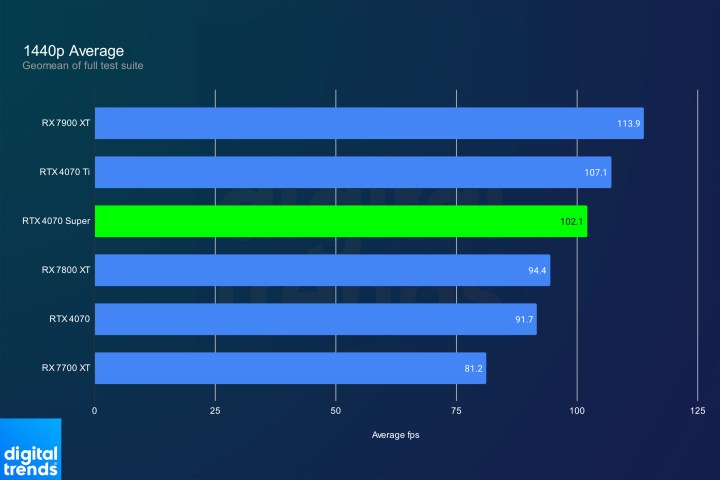
Nvidia calls the RTX 4070 Super a 1440p graphics card, and it’s no wonder. The card hits its stride at this resolution. It comes out 11% ahead of the base RTX 4070 and a solid 8% ahead of AMD’s RX 7800 XT. It’s also only 5% slower than the RTX 4070 Ti, which is a testament to how overpriced that card was when Nvidia first introduced it.
The card gains some ranking in Cyberpunk 2077 and Resident Evil 4, but it remains behind the competition. Both of these titles clearly favor AMD GPUs in the current generation, however. As you can see from these tests, even the RX 7800 XT ends up faster than the RTX 4070 Ti, whereas my average above tells a far different story.
On the other end of the story is Red Dead Redemption 2, where the RTX 4070 Super actually managed to beat the RTX 4070 Ti by a few frames. It managed similar performance in Assassin’s Creed Valhalla, matching the RTX 4070 Ti.
Those are the bookends at 1440p, but the bits in the middle aren’t bad. In Horizon Zero Dawn, the RTX 4070 Super ends up 14% faster than the base model and 11% faster than the RX 7800 XT, falling just short of the RTX 4070 Ti. The card doesn’t look quite as impressive in Returnal, just narrowly winning over the RX 7800 XT. A lead is still a lead in this demanding title, however.
1080p gaming
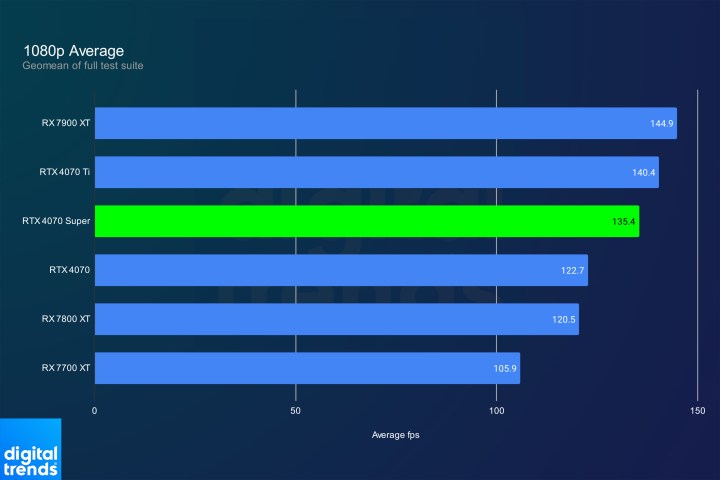
Down at 1080p, the lead the RTX 4070 Super sees at higher resolutions slips just a bit due to a CPU bottleneck. It ends up around 10% faster than the RTX 4070 and about 4% slower than the RTX 4070 Ti. Everything narrows a bit, which is what you’d expect at 1080p for a $600 graphics card.
In actual games, the story is fairly similar to what we’ve seen above, with narrower margins. I’m not going to rehash all of my benchmarks here because, frankly, a $600 graphics card is really best suited for 1440p or 4K. If you’re still rocking a 1080p display, something like AMD’s RX 7600 or Nvidia’s RTX 4060 is probably a better fit.
Ray tracing
Ray tracing has become a staple in modern games, and Nvidia still clearly has a lead on that front. There’s no better example of that than Resident Evil 4. Without ray tracing, the RTX 4070 Super looks pitiful in this game, but flip the switch, and it falls in line with the other games we’ve seen. Across resolutions, it ends up shy of the RTX 4070 Ti while managing to beat the RX 7800 XT and RTX 4070.
Still, that’s the worst showcase of the card. In Cyberpunk 2077, where the RTX 4070 Super put up disappointing results previously, it joins an elite squad with the RTX 4070 Ti as its neighbor. This is a great showcase of Nvidia’s DLSS 3.5, too, where you can see how upscaling and frame generation massively improve smoothness.
In Returnal, we see a similar story. In this title, however, the RTX 4070 Super ends up with a stronger lead over the RTX 4070 and RX 7800 XT, edging slightly closer to the RTX 4070 Ti.
Should you buy the RTX 4070 Super?

The RTX 4070 was already a great graphics card. The main goal with the RTX 4070 Super for Nvidia was to get ahead of the competition from AMD and justify that original $600 price tag. And this card manages to do both, and sometimes a bit more.
It doesn’t scale up quite as high as the specs would suggest, but considering the foundation of the RTX 4070 Super was so solid, Nvidia didn’t need to push the card that hard. At $600, there’s nothing better than the RTX 4070 Super.
One interesting byproduct of this graphics card is the base RTX 4070. Nvidia says it will continue selling the base model for $550. At that price, the Super model is an easy pick. However, if prices start slipping to around $500, it definitely becomes a lot more attractive, even with the Super version making the rounds.
Editors’ Recommendations
